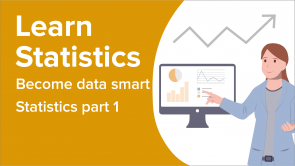Experiments and Observational Studies

Über den Vortrag
Der Vortrag „Experiments and Observational Studies“ von David Spade, PhD ist Bestandteil des Kurses „Statistics Part 1“. Der Vortrag ist dabei in folgende Kapitel unterteilt:
- Experiments and observational studies
- Why do Observational Studies?
- Designing an Experiment
- Principles of Experimental Design
- Diagramming an Experiment
- Experiments and Surveys
- Placebos and their Uses
- Randomized Block Designs
Quiz zum Vortrag
When we use records from past observations to evaluate the responses, what type of study have we conducted?
- We have conducted a retrospective study.
- We have conducted a survey.
- We have conducted a prospective study.
- The information provided in this question is not sufficient to determine what kind of study has been conducted.
- We have conducted a cohort study.
Why are observational studies useful?
- Observational studies allow us to examine the relationship between two variables.
- Observational studies allow us to establish cause and effect relationships between two variables.
- Observational studies allow us to determine whether we have found the explanatory variables that have the largest effect on the response.
- Observational studies allow us to evaluate the placebo effect.
- Observational studies are useful to determine the maximum safe dose of a drug.
What is a difference between an observational study and an experiment?
- In an experiment, the researcher assigns treatments, while in an observational study, treatments are not assigned.
- In an observational study, the researcher assigns treatments, while in an experiment, treatments are not assigned.
- Experiments can be used to study relationships between two variables, while observational studies cannot be used in this way.
- An observational study allows us to infer cause and effect relationships, while experiments do not.
- Only observational studies regularly look at toxicity outcomes.
What is the relationship for a variable that masks the effect of another variable?
- We say that these variables are confounded.
- We say that these are lurking variables.
- We say that these variables are factors.
- We say that these variables are treatments.
- We say these variables are atypical.
What are ‘experimental units’?
- Non-human individuals on whom experiments are performed
- Numbers involved in experiments
- The one who conducts the experiments
- The one who pays for the experiments
- The one who create hurdles in the experiment
Who are the ‘subjects’ in the context of experiments?
- Individuals on whom experiments are performed
- Numbers involved in experiments
- The one who conducts the experiments
- The one who pays for the experiments
- The one who creates hurdles in the experiment
What is a control treatment?
- A control treatment is a baseline measurement used to help decide whether a treatment has an effect on the response.
- A control treatment is a complex tool used to help decide whether a treatment has an effect on the independent variable.
- A control treatment is a false replication of the original treatment.
- A control treatment is a method of removing outliers.
- A control treatment is one that has no effect on the response.
What is the type of blinding for a study in which only one of the parties (i.e. either the subject or the researcher) knows what treatment the subject is receiving?
- Single-blind
- One-blind
- Triple -blind
- No-blind
- Single-bind
What type of blinding is described when neither of the parties (i.e. either the subject or the researcher) knows which treatment the subject is receiving?
- Double-blind
- Both-blind
- One-blind
- Triple-blind
- Double-bind
Kundenrezensionen
5,0 von 5 Sternen
| 5 Sterne |
|
5 |
| 4 Sterne |
|
0 |
| 3 Sterne |
|
0 |
| 2 Sterne |
|
0 |
| 1 Stern |
|
0 |





